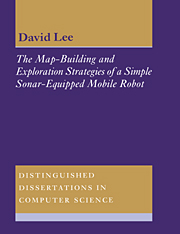 The Map-Building and Exploration Strategies of a Simple Sonar-Equipped Mobile Robot
The Map-Building and Exploration Strategies of a Simple Sonar-Equipped Mobile Robot Published online by Cambridge University Press: 05 March 2012
Section 4.1 described the attraction of wall-following as an exploration strategy and gave examples of its use in a number of research projects. It was argued in Section 4.3 that wall-following should be the first strategy to be implemented and tested because it will give an indication of what can be achieved when ARNE acts only on the basis of immediatelyavailable information and does not use the map to guide its exploration. This chapter describes the way in which wall-following was implemented on ARNE and presents the results of some explorations using this strategy.
12.1 Implementation
Wall-following has been implemented in two stages. First, ARNE approaches the nearest object that it can detect and positions itself ready for wall-following proper to start. The bulk of the exploration is then a repetitive process of ‘scan,turn,move’ actions in which ARNE moves so as to maintain an ideal distance from the nearest detected object. The remainder of this section describes the implementation of these two stages.
The first stage is quite simple. ARNE performs a complete sensor scan and groups the raw returns into readings, as described in Section 6.3. ARNE then selects the smallest range reading and moves so as to be at a standard distance, IDEAL-WALL-CLEARANCE, from the object. If the minimum range is greater than IDEAL-WALL-CLEARANCE, this means turning in the direction of the minimum reading. Otherwise ARNE turns directly away from the shortest reading.
To save this book to your Kindle, first ensure [email protected] is added to your Approved Personal Document E-mail List under your Personal Document Settings on the Manage Your Content and Devices page of your Amazon account. Then enter the ‘name’ part of your Kindle email address below. Find out more about saving to your Kindle.
Note you can select to save to either the @free.kindle.com or @kindle.com variations. ‘@free.kindle.com’ emails are free but can only be saved to your device when it is connected to wi-fi. ‘@kindle.com’ emails can be delivered even when you are not connected to wi-fi, but note that service fees apply.
Find out more about the Kindle Personal Document Service.
To save content items to your account, please confirm that you agree to abide by our usage policies. If this is the first time you use this feature, you will be asked to authorise Cambridge Core to connect with your account. Find out more about saving content to Dropbox.
To save content items to your account, please confirm that you agree to abide by our usage policies. If this is the first time you use this feature, you will be asked to authorise Cambridge Core to connect with your account. Find out more about saving content to Google Drive.